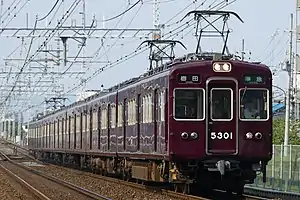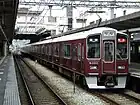Hankyu 5300 series
The Hankyu 5300 series (阪急電鉄5300系) is an electric multiple unit (EMU) train type operated in Japan by the private railway operator Hankyu Railway since 1972.[1]
| Hankyu 5300 series | |
|---|---|
 A 5300 series set taken in 2018 | |
| In service | 1972– |
| Manufacturer | Alna Kōki |
| Constructed | 1972-1984 |
| Entered service | 1972 |
| Refurbished | 1989, 2002-2003 |
| Number built | 105 vehicles (19 sets) |
| Number in service | 96 vehicles (13 sets) |
| Number scrapped | 9 vehicles |
| Formation | 7/8 cars per trainset |
| Fleet numbers | 5300-5324 |
| Capacity | 48/92 (primary car) 52/98 (secondary car) |
| Operator(s) | Hankyu Railway |
| Line(s) served | |
| Specifications | |
| Car body construction | Steel |
| Car length | 18,900 mm (62 ft 0 in) |
| Width | 2,809 mm (9 ft 2.6 in) |
| Height | 4,095 mm (13 ft 5.2 in) |
| Doors | 3 pairs per side |
| Maximum speed | 115 km/h (71.5 mph) |
| Weight | 37,100 kg (37.1 t) |
| Traction system | Resistor control TDK8550-A |
| Power output | 140 kW (188 hp) |
| Acceleration | 2.6 km/(h⋅s) (1.6 mph/s) 2.8 km/(h⋅s) (1.7 mph/s)(sakaisuji line) |
| Deceleration | 3.7 km/(h⋅s) (2.3 mph/s) 4.2 km/(h⋅s) (2.6 mph/s) (emergency) |
| Electric system(s) | 1,500 V DC overhead catenary |
| Current collector(s) | Pantograph |
| Braking system(s) | Dynamic brake Electronically controlled pneumatic brakes |
| Safety system(s) | ATS, ATC, Deadman's switch |
| Coupling system | Shibata-type |
| Track gauge | 1,435 mm (4 ft 8+1⁄2 in) |
Operation
The 5300 series consists of eight-car and seven-car sets.
Seven car sets are not allowed on the Sakaisuji Line.
Formations
As of December 2020, the fleet consists of 96 cars formed as eight-car and seven-car sets as follows, with two car spares. All "Mc" 5300 cars are at the Umeda end while all lead car "M'c" 5400 cars are at the Kyoto-Kawaramachi and Kita-Senri end.[2]
8-car sets
| Car No. | 1 | 2 | 3 | 4 | 5 | 6 | 7 | 8 |
|---|---|---|---|---|---|---|---|---|
| Designation | Mc | M'c | Mc | M' | T | M | M'c | |
| Numbering | Mc 5300 | Mc 5400 | Mc 5300 | Mc 5400 | T 5850 | M 5900 | Mc 5400 | |
- The "Mc" and "M" cars are each fitted with two scissors-type pantographs.
7-car sets
| Car No. | 1 | 2 | 3 | 4 | 5 | 6 | 7 |
|---|---|---|---|---|---|---|---|
| Designation | Mc | T | M'c | Mc | T | T | M'c |
| Numbering | Mc 5300 | T 5850 | Mc 5400 | Mc 5300 | T 5850 | Mc 5400 | |
| Designation | Mc | M' | T | M | M'c | ||
| Numbering | Mc 5300 | M 5800 | T 5850 | M 5900 | Mc 5400 | ||
| Designation | Mc | T | M'c | Mc | T | M'c | |
| Numbering | Mc 5300 | T 5850 | Mc 5400 | Mc 5300 | T 5850 | Mc 5400 | |
- The "Mc" and the "M" cars are each fitted with two scissors-type pantographs.
2-car spare set
| Car No. | 1 | 2 |
|---|---|---|
| Designation | M' | |
| Numbering | M 5800 | |
Interior
Passenger accommodation consists of longitudinal bench seating throughout.[1] Paneling is made of faux wood.
Gallery
 Inside a 5300 series car
Inside a 5300 series car A 5300 series set after renewal work. Note the drivers cabs sandwiched in the middle of the trainset
A 5300 series set after renewal work. Note the drivers cabs sandwiched in the middle of the trainset
References
- 山口, 益生 (29 June 2012). 阪急電車 [Hankyu Train] (in Japanese). Tokyo, Japan: JTB Publishing. pp. 181–183. ISBN 978-4533086984.
- "Hankyu Railway Fan Club Bulletin". Hankyu Railway. 88.
Wikimedia Commons has media related to Hankyu 5300 series.
This article is issued from Wikipedia. The text is licensed under Creative Commons - Attribution - Sharealike. Additional terms may apply for the media files.
